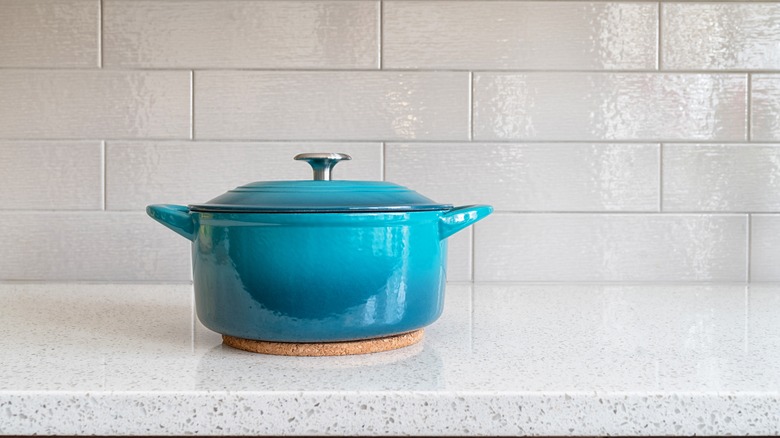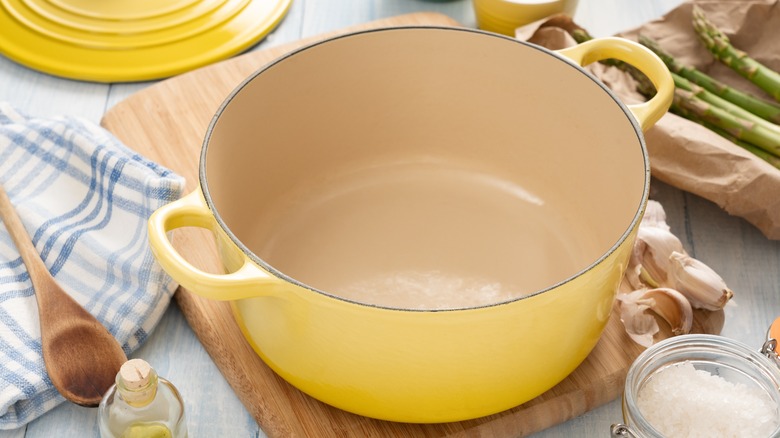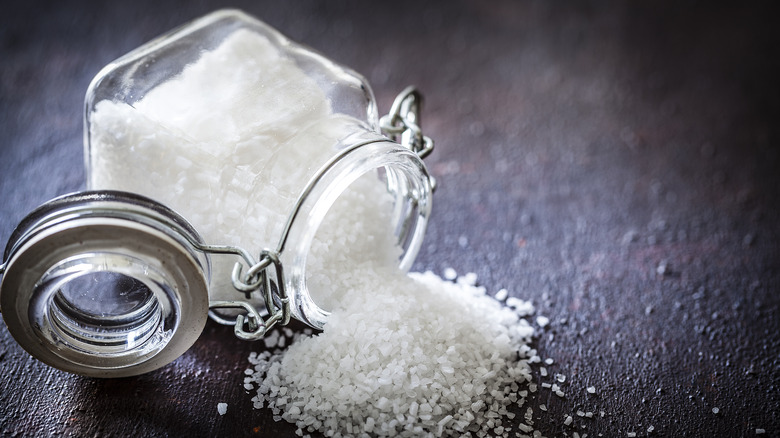This Common Kitchen Ingredient Is The Answer For Cleaning A Dutch Oven
The Dutch oven is a versatile cooking tool and, in many cases, a family heirloom, because if you take good care of them, most will last for years. They come in several materials, like cast iron and ceramic. While there's still debate on what substance is the best, there's no denying that they all are susceptible to stuck-on messes.
Cleaning a Dutch oven is a delicate process. A harsh scrub brush can ruin the interior, yet something abrasive is needed to lift the caked-on food. This can lead to frustration when trying to find an effective cleaning solution. Luckily, salt can get the job done. Salt is an impressive yet gentle cleaning material that you can even use to remove tough fabric stains.
Because they are typically used as a slow cooker, food and liquids tend to harden and cling to the inside of Dutch ovens. Salt is effective enough to lift that solidified mess without causing damage, so you can continue to use your Dutch oven meal after meal. You'll need coarse salt, paper towels, and some cooking oil. In some cases, you may also want to grab a lemon for good measure.
How to clean a dutch oven with salt
The interior material of a Dutch oven often dictates how it should be cleaned. It's also important to consider how old the mess is, as that will tell you what it can and cannot be cleaned with. For example, dish soap may work for newer messes in enamel-coated Dutch ovens but won't lift older burned or caked-on foods. Thankfully, salt is a suitable solution for multiple interior types, new messes and old ones.
You should begin cleaning by using a paper towel to remove any large and loose pieces of food. Next, sprinkle coarse salt into a warmed pot. Take another paper towel or soft rag and begin scrubbing the Dutch oven. Use circular motions to gently grind the grains of salt against the scorched or stuck-on particles. For really stubborn messes, use a halved lemon instead of a paper towel. Once you've removed the residue, rinse the interior with warm water. Dry the inside immediately, and follow up with a new coating of oil. It's important to always coat a Dutch oven after cleansing, no matter the material. This is especially crucial for cast iron models.
Why is salt an effective cleaning agent?
Salt is an effective cleaning solution because it's abrasive enough to scratch away stubborn stains but is not as harsh as hard plastic or metal bristles. While cast iron can handle a wire brush, enamel-coated and ceramic Dutch ovens will get scratched. Dutch oven warranties, like the one at Le Creuset, cover chips and cracks but do not cover scratching caused by misuse — which, in this case, would be improper cleaning. Using a gentler scrubbing method, like salt, will not damage your Dutch oven or void your warranty.
When it comes to cast iron, it's often said that you should never clean it with dish soap. That's because, in years past, dish soap was made with lye, which would strip away the cast iron's seasoning and damage the metal. Nowadays, dish soap is milder and safer to use. However, it's still ineffective for older, set-in messes. Salt plus heat will thwart the muck that cannot be lifted by soap.


